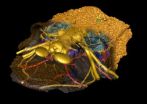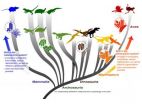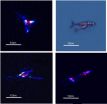(Press-News.org) This news release is available in German.
Hookworms and whipworms are detrimental to health. Children in many developing countries in particular are prone to regular infection via contaminated soil due to a lack of latrines and clean water. Whipworm eggs enter the body via the gastrointestinal tract and evolve over several devel-opment stages. To contain the health risks of worm infections, the WHO recommends annual de-worm treatment for children and at-risk groups (such as field hands and miners). However, the recommended standard treatment appears to have little effect against the widespread whipworm (Trichuris trichiura).
"We remembered that there was an effective deworming drug used in veterinary medicine," says head of the study Jennifer Keiser, from the Swiss Tropical and Public Health Institute. Following a preliminary study in the laboratory, her group tested the veterinary treatment 'Oxantel Pamoate' in combination with the standard treatment, Albendazole. The randomised double-blind trial with school children with worm infections took place on the East African island of Pemba (Tanzania). After one treatment with this combination therapy, 31% of the children were free of worm infec-tions. The number of worm eggs in the children's stools decreased by 96% after one treatment.
Veterinary medicine for neglected worm infections
'Oxantel Pamoate' was developed in the 1970s to combat whipworm. Today, it is widely used in veterinary deworming drugs in combination with other substances. Studies in the 1970s showed that 'Oxantel Pamoate' is also a safe and effective way of tackling whipworm infections in humans. Yet, the drug was soon forgotten about and was never widely used for humans.
"Health experts in the field of worm infections have been discussing its use for some years now," says Jennifer Keiser: "The problem was the availability of the active ingredient as a single sub-stance." The veterinary medicine manufacturers did not want to release the drug for human clini-cal trials and the drug is not commercially available.
Successful collaboration with pharmacists at the University of Basel
The solution was found during a collaboration with pharmacists at the University of Basel. Jörg Huwyler's laboratory in the Centre for Pharmaceutical Sciences succeeded in producing a tablet whose taste and colour were attractive to children. Thanks to this expertise, it was possible to de-velop the substance entirely independently of the pharmaceutical industry.
Drug doses and delivery are currently being improved in further clinical trials. On the strength of the study, the WHO could extend its recommendation to include this substance in future. This would improve the health of millions of children worldwide.
INFORMATION:
The study was financed by the Swiss National Science Foundation (SNSF) and the Medicor Foun-dation.
Study
Oxantel Pamoate-Albendazole for Trichuris trichiura Infection. B. Speich, SM. Ame, SM. Ali, R. Alles, J. Huwyler, J. Hattendorf, J. Utzinger, M. Albonico , and J. Keiser, Ph.D. N Engl J Med 770;7, p. 610ff.
Contacts
Professor Jennifer Keiser, Swiss Tropical and Public Health Institute
jennifer.keiser@unibas.ch, Tel +41 61 284 82 18
Benjamin Speich, Swiss Tropical and Public Health Institute
benjamin.speich@unibas.ch, Tel +41 61 284 82 86
Dr. Christian Heuss, Communication, Swiss Tropical and Public Health Institute
christian.heuss@unibas.ch, Tel +41 61 284 86 83
About the Swiss Tropical and Public Health Institute (Swiss TPH)
The Swiss Tropical and Public Health Institute (Swiss TPH) is one of Switzerland's leading public and global health institutions. Associated with the University of Basel, the Institute combines re-search, teaching and service provision at local, national and international level. The Swiss TPH is a public sector organisation and receives around 17% of its budget of approximately 80 million francs from core contributions from the cantons of Basel-Stadt and Basel-Landschaft (10%) and from the federal government (8%). The remainder (82%) is acquired by competing for funds. The Institute has more than 600 employees working in 20 countries. Professor Marcel Tanner is head of the Institute.
Worm infections in developing countries: Veterinary drugs improve the health of school children
2014-02-13
ELSE PRESS RELEASES FROM THIS DATE:
New research uncovers debilitating effects of disease on toy dog breeds
2014-02-13
A new study from the University of Surrey, published today in the journal PLOS One, has identified the specific effect Chiari malformation has on the shape of a dog's skull and brain. This condition has become prevalent as a result of selective breeding and affects many toy dog breeds which have been bred to look more doll-like, including Griffon Bruxellois, Cavalier King Charles Spaniels, Chihuahuas and their crosses.
Researchers took brain, skull and vertebrae measurements of 155 Griffon Bruxellois and compared dogs affected by the condition, with normal Griffons. ...
Jawed vertebrates get a face
2014-02-13
This week in the leading journal Nature, a team of French and Swedish researchers present new fossil evidence for the origin of one of the most important and emotionally significant parts of our anatomy: the face. They show how a series of fossils, with a 410 million year old armoured fish called Romundina at its centre, documents the step-by-step assembly of the face during the evolutionary transition from jawless to jawed vertebrates.
Vertebrates (backboned animals) come in two basic models: jawless and jawed. Today, the only jawless vertebrates are lampreys and hagfishes, ...
Quality of acupuncture needles is less than perfect and must improve
2014-02-13
The quality of acupuncture needles is high, but should still be universally improved to avoid potential problems, such as pain and skin reactions, finds research published online in Acupuncture in Medicine (AiM).
Despite improvements to the manufacturing process, surface irregularities and bent tips have not been completely eliminated, say the researchers.
In China, traditional Chinese medicine including acupuncture, accounts for 40% of all medical treatment, while in the West, acupuncture is one of the most frequently used complementary therapies.
An estimated 1.4 ...
Tobacco industry claims 'plain' packs won't work based on weak evidence
2014-02-13
Tobacco companies lack strong, relevant evidence to support their claims that standardised (plain) packaging of tobacco products in the UK won't work, finds research published in the online journal BMJ Open.
The aim of plain packaging, with no logos, brand imagery, symbols, or promotional text, is to restrict the already limited opportunities that transnational tobacco companies have to market their products, and deter people from starting smoking.
Australia adopted plain packaging for tobacco products in 2012, the same year that the Department of Health in England ...
Hospitals not always prepared for full costs of implementing electronic patient records
2014-02-13
Hospitals don't always take into account the full costs of implementing new electronic health record systems and should be better prepared if they are to maximise the benefits, finds research published online in the Journal of the American Medical Informatics Association (JAMIA).
Electronic health record (EHR) systems can improve the safety, quality, and efficiency of healthcare in hospitals, and their adoption is a priority for the UK and US governments.
But despite their promise and the existence of EHRs in UK primary care for several decades, UK hospitals have been ...
Revision to rules for color in dinosaurs suggests connection between color and physiology
2014-02-13
New research that revises the rules allowing scientists to decipher color in dinosaurs may also provide a tool for understanding the evolutionary emergence of flight and changes in dinosaur physiology prior to its origin.
In a survey comparing the hair, skin, fuzz and feathers of living terrestrial vertebrates and fossil specimens, a research team from The University of Texas at Austin, the University of Akron, the China University of Geosciences and four other Chinese institutions found evidence for evolutionary shifts in the rules that govern the relationship between ...
Many stroke patients on 'clot-busting' tPA may not need long stays in the ICU
2014-02-13
A Johns Hopkins study of patients with ischemic stroke suggests that many of those who receive prompt hospital treatment with "clot-busting" tissue plasminogen activator (tPA) therapy can avoid lengthy, restrictive monitoring in an intensive care unit (ICU).
The study challenges the long-standing protocol that calls for intensive monitoring, mostly done in ICUs, for the first 24 hours after tPA infusion to catch bleeding in the brain, a side effect seen in 6 percent of patients treated with the medication.
Results show that a relatively simple measure of stroke severity ...
Whales viewed from space
2014-02-13
High-resolution satellite images may be a useful tool for counting whale populations for conservation purposes, according to a study published in PLOS ONE on February 12, 2014 by Peter Fretwell from British Antarctic Survey, UK, and colleagues.
In the study, the authors selected one of the largest southern right whale populations, breeding off the Argentinian coast. The population was selected, due to its large size and tendency to bask near the surface in large aggregations around sheltered coastal waters during breeding season. Scientists used this population to test ...
Mathematical beauty activates same brain region as great art or music
2014-02-13
People who appreciate the beauty of mathematics activate the same part of their brain when they look at aesthetically pleasing formula as others do when appreciating art or music, suggesting that there is a neurobiological basis to beauty.
There are many different sources of beauty - a beautiful face, a picturesque landscape, a great symphony are all examples of beauty derived from sensory experiences. But there are other, highly intellectual sources of beauty. Mathematicians often describe mathematical formulae in emotive terms and the experience of mathematical beauty ...
Two strategies for accurate dart throwing
2014-02-13
Timing of dart release or hand position may improve dart throwing accuracy, according to a study published in PLOS ONE on February 12, 2014 by Daiki Nasu from Osaka University, Japan and colleagues.
Two major strategies are attributed to accurate throwing: timing the object release, and the using hand positioning at release to compensate for releasing the object at variable times. To better understand these strategies, researchers investigated whether expert dart players utilize hand movement that can compensate for the variability in their release timing. The study compared ...



